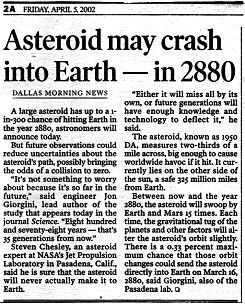 |
  |
 |
updated: August 11, "2006"
Quotes About Being Unprepared for Asteroids |
|

What's New & Previews
Jimi's Prediction —
A Remote View About Jimi Hendrix Timeline Blog Asteroid Impact Evolution Woodstock Blues Jimi Code VS. Da Vinci Code Credit Thefts Missile Agency/Moon Base Charade Remote View Mutation Seattleland Censorship Events Skewed Science Search Engine Rankings Download An Ad AT&T: New Nuremberg Wall(y)flower Syndrome Rochester Media DVD/CD Store More Links... 
Page 4 of 7
"If something sneaks up on us there is very little we can do. In fact today, the most likely situation is zero warning. The next impact of a mile wide object will probably happen without any prior discovery of it at all. The first thing you'll know is that you'll feel the ground shake and see a plume of fire coming up over the horizon."
- Dr. David Morrison, Director of Space for NASA-Ames,
Asteroid - Deadly Impact, National Geographic, NBC 2/26/97
 Of note regarding this April 5, 2002 report is the quote from NASA asteroid expert Steven Chesley, who says "future generations will have enough knowledge and technology to deflect it" - the implication/admission is that such knowledge and technology is lacking among today's generations. And as Rock Prophecy points out, that knowledge and technology will not become available to us before a Rock knocks the lights out on this civilization. Boris Kartogin, general director and designer at rocket producer Energomash in Moscow claims, "If a massive asteroid threatens Earth, a powerful space-based laser could be used to destroy it." Kartogin said the laser defense scheme would require the assembly of 10 to 12 platforms in Earth's orbit, which would then be equipped with powerful, chemical lasers capable of destroying the approaching asteroid. He added that "a laser of such power does not yet exist, but the international community is seriously talking about the need to create one." - MSN 7/26/02
. The Contour space probe is lost in space as NASA loses contact with the $159 million craft designed to chase and study comets. Another set back for our efforts, centuries delayed, to prevent the impact that will soon blow away our civilization. - 8/15/02
. "Space rocks change trajectories often. And our planet’s vulnerability to them is highlighted by the fact that asteroid 2002-NY30 was first spotted by astronomers only a month earlier on July 14. Don Yeomans, who manages NASA's Near-Earth Object Program at the Jet Propulsion Laboratory in Pasadena, California, said, 'Asteroids are hard to see because they're mostly black like charcoal.'"
- CNN 8/18/02
“At least 30 times per year a space rock…slashes into the Earth’s atmosphere and explodes, releasing energy equal to that of an atomic bomb,” Air Force Brig. Gen. Simon Worden told members of a House Science subcommittee…Worden said the Air Force…in 1996 detected an asteroid burst over Greenland that released energy equal to about 100,000 tons of explosives. He said similar events…occurred in 1908 over Siberia, in the 1940s over Central Asia and over the Amazon basin in the 1930s. “Had any of these rocks struck over a populated area, thousand, perhaps hundreds of thousands might have perished,” he said…Edwarsd Weiler, head of NASA’s office of space science, told the House committee that his agency…is finding about 100 new [near Earth objects] each year…if an asteroid the size of a cruise ship smashed into the ocean, it could cause huge waves capable of drowning coastal cities on two continents. - Associated Press 10/3/02
(quotes continue below...)
. Residents in Utah, Colorado and southern Wyoming saw a huge fireball that raced across the night sky. "It was probably a meteor burning up in the atmosphere," said Peter Wilensky, meteorologist with the National Weather Service/Colorado Basin River Forecast Center. No man-made objects fell from space Sunday night, said Maj. Ed Thomas, a spokesman for the North American Aerospace Defense Command in Colorado Springs, Colorado, which tracks satellites and space debris. "We don't have a mission to track meteorites, but that's got to be what it is," Thomas said. - CNN 10/7/02
Clark Chapman, Piet Hut, Ed Lu, and Rusty Schweickart establish the "B612 Foundation" with the goal to "significantly alter the orbit of an asteroid"...The Foundation's mission statement explains, "We are a group of professionals, primarily scientists and other technical people, who are involved in and concerned about the current lack of action to protect the Earth from the impact of near Earth asteroids (NEAs)...the consequence of such an occurrence is extreme, and mitigation efforts should begin now. "The reality of concern to us, among others, is that the discovery of a NEA headed toward an impact with Earth could be announced at any time by the Spaceguard program. If this were to happen the public would be extremely concerned and demand to know what is being done about it. Unfortunately the answer is "nothing". This, it seems to us, is intolerable and could cause widespread alarm." - B612 Foundation 10/7/02
Testimony at a Congressional hearing with Gen. Ronald Kadish, Director of the Missile Defense Agency: CONGRESSMAN: Would you be able to say in 2004 that you'd be able to shoot [a missile] down 10 percent of the time? GEN. KADISH: I don't know. CONGRESSMAN: Twenty percent of the time? If the North Koreans were to launch one missile, after giving you a week's notice of where they were going to launch that one missile from, and also informing you that there would be no decoys, just one missile - after $60 billion, what is the probability that you could shoot that one missile down? GEN. KADISH: Zero, as of today.
- Frontline - PBS 10/10/02
|
| © 2006 First Century Press. All Rights Reserved. Contact Us |
